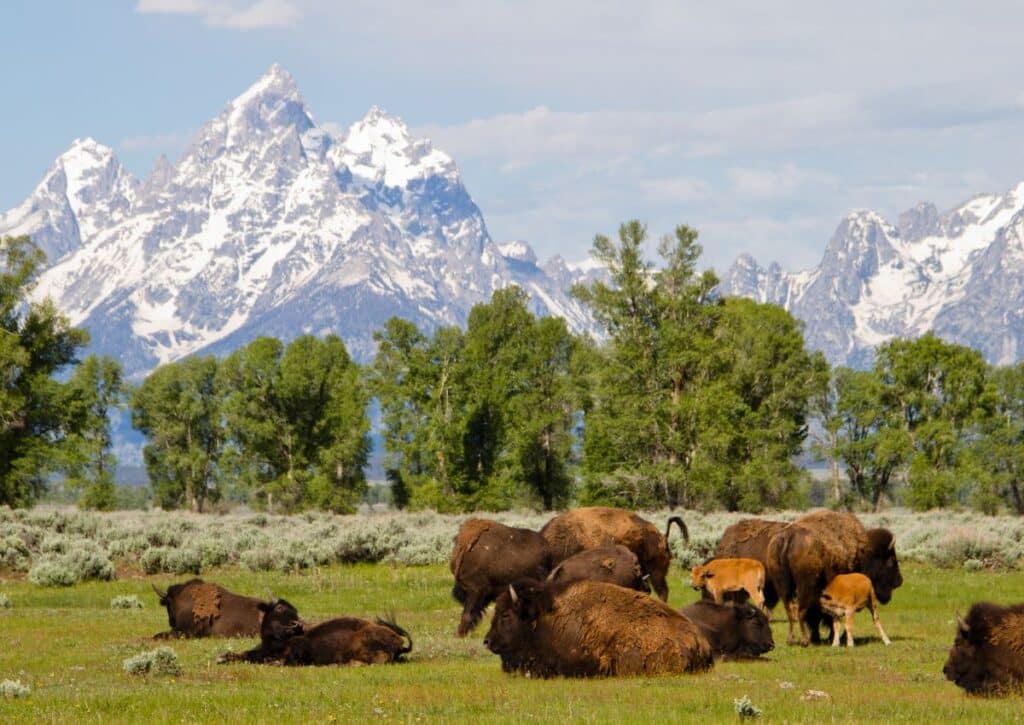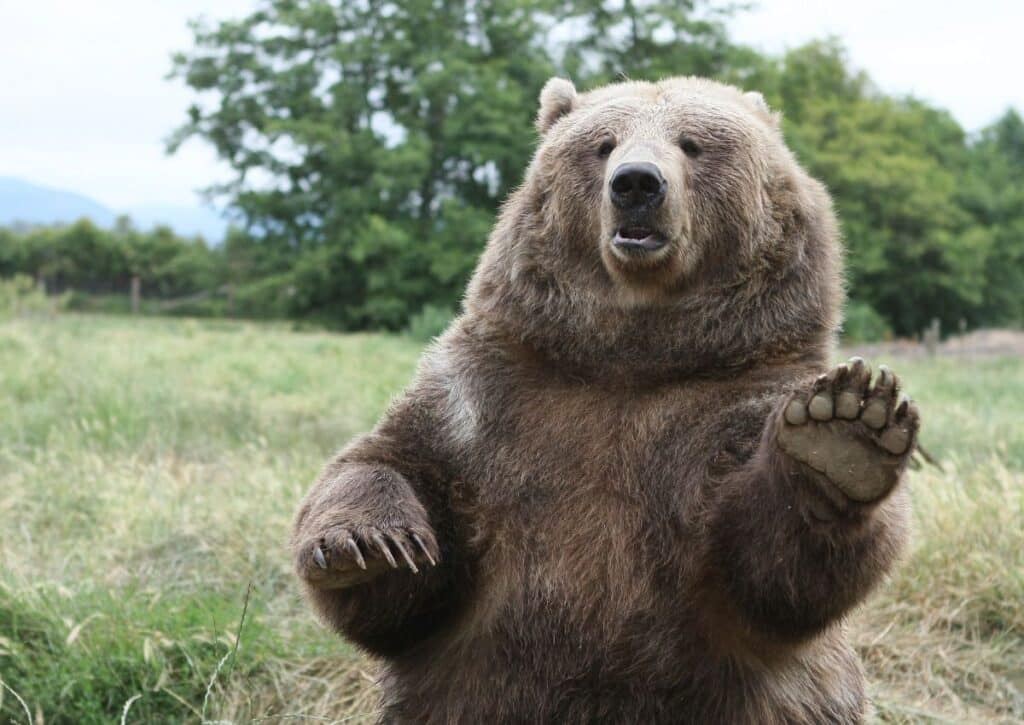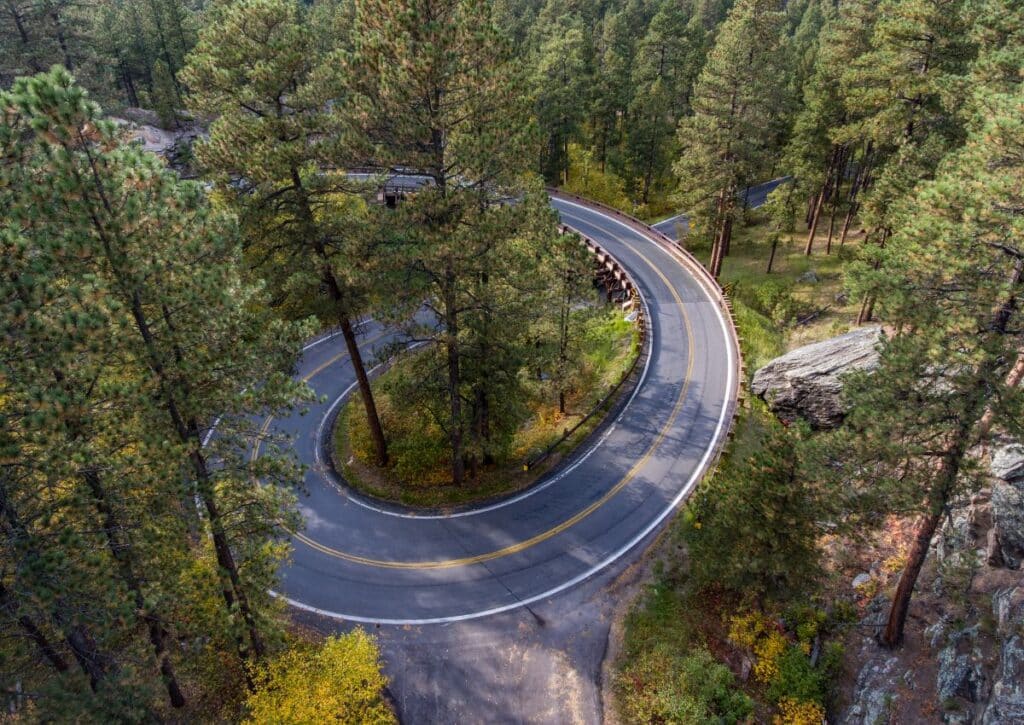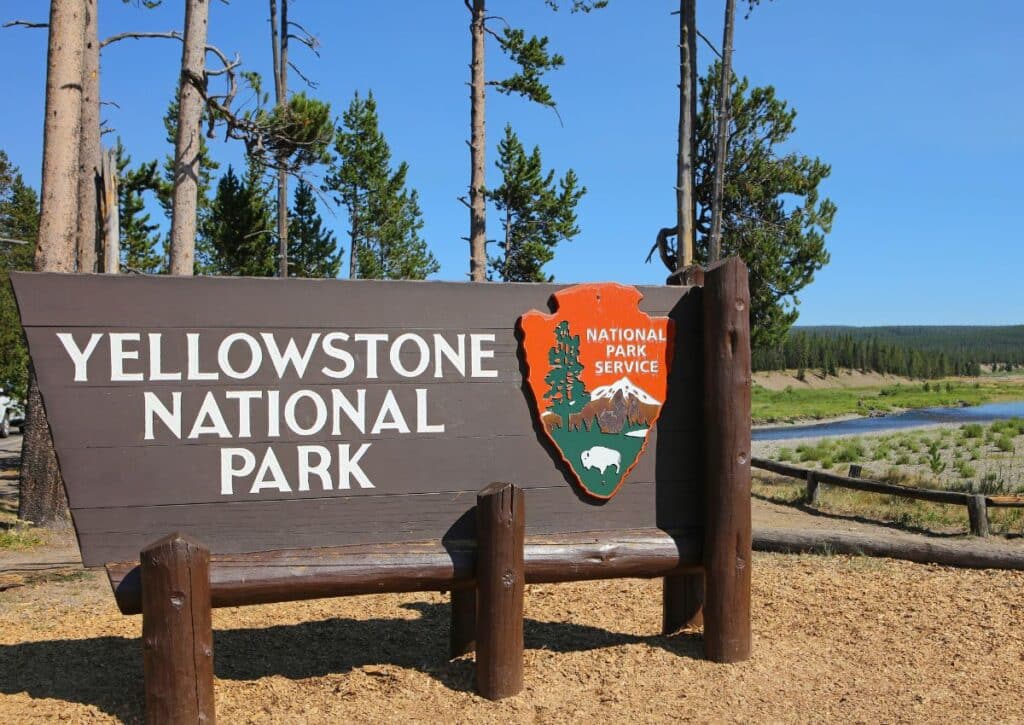Comparing Grand Teton National Park vs Yellowstone: Dive into park sizes, stunning sceneries, hikes, wildlife, amenities, and decide which to visit
When deciding between visiting Grand Teton National Park or Yellowstone National Park in Wyoming, it is recommended to visit both if possible.
However, if you have to choose, here is some information to help you make a decision.
Key Takeaways:
- Yellowstone is the older and larger park, covering around 3,500 square miles compared to Grand Teton’s 484 square miles.
- Yellowstone offers a diverse range of geothermal features, including the famous Old Faithful geyser and its own Grand Canyon.
- Grand Teton is known for its stunning mountain scenery, crystal-clear glacial lakes, and extensive network of hiking trails.
- Both parks offer excellent opportunities for wildlife viewing, with the “big five” animals regularly spotted. Yellowstone has the largest bison herd in the US.
- Grand Teton is located closer to the town of Jackson and can be easily explored in a shorter amount of time, while Yellowstone requires more driving and time to fully experience.
- Both parks have similar entrance fees and offer dining and accommodations, with Yellowstone offering more options in both categories.
- Ultimately, there is no wrong answer when it comes to choosing between the two parks, as both offer unique natural beauty and experiences.
Park Size and Features
When it comes to size and features, Yellowstone National Park takes the lead. Covering around 3,500 square miles, Yellowstone is not only the older of the two parks but also significantly larger than Grand Teton, which spans only 484 square miles.
The vast expanse of Yellowstone allows for a greater variety of landscapes and attractions to explore.
One of the standout features of Yellowstone is its geothermal wonders. The park is renowned for its geysers, including the iconic Old Faithful, which erupts like clockwork.
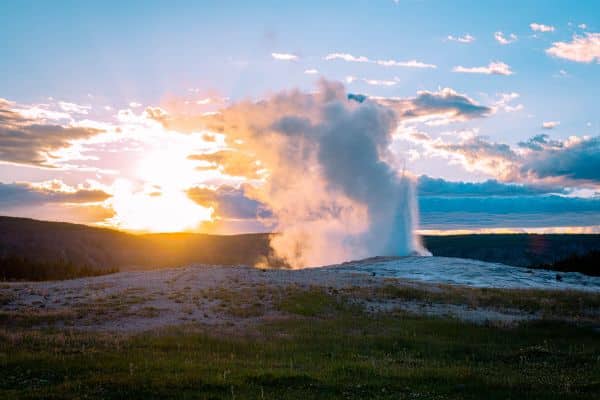
You can also visit Yellowstone’s own Grand Canyon, with its stunning waterfalls and colorful cliffs. The geothermal activity in the park creates a unique and otherworldly landscape that is truly awe-inspiring.
“Yellowstone National Park is a geothermal wonderland, offering a one-of-a-kind experience with its geysers, hot springs, and the majestic Grand Canyon,” said park ranger Jane Smith. “Visitors are treated to a spectacle of natural wonders that can’t be found anywhere else.”
On the other hand, Grand Teton National Park offers its own set of impressive features. The park is known for its majestic mountain scenery, with the towering peaks of the Teton Range creating a dramatic backdrop.
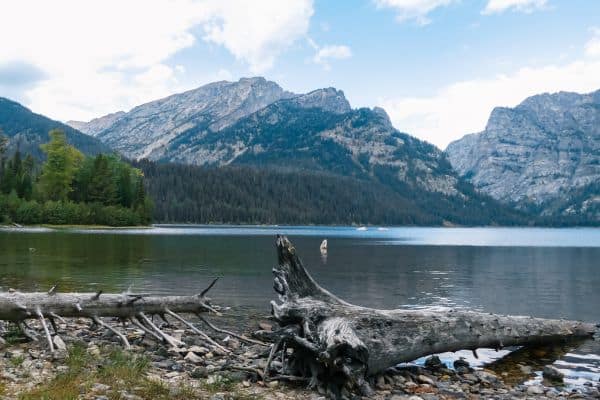
Crystal-clear glacial lakes dot the landscape, providing opportunities for serene reflection and beautiful photo opportunities.
The park’s extensive network of hiking trails allows visitors to immerse themselves in the breathtaking beauty of the mountains.
Yellowstone’s geothermal features include:
Old Faithful geyser
The Grand Canyon of Yellowstone
Mammoth Hot Springs
Grand Teton’s scenic features include:
The Teton Range
Jackson Lake
Jenny Lake
Considering the size and features of both parks, Yellowstone National Park offers a more diverse range of attractions and geothermal wonders.
However, Grand Teton National Park showcases the beauty of the Teton Range and offers unparalleled mountain scenery.
Whether you choose to visit one park or both, you are guaranteed to witness nature’s splendor and create lasting memories in either Grand Teton National Park or Yellowstone National Park.
Stunning Scenery and Outdoor Activities
Whether you’re seeking breathtaking mountain views or thrilling outdoor activities, both Grand Teton National Park and Yellowstone National Park have plenty to offer.
Grand Teton is renowned for its majestic mountains, including the iconic Grand Teton peak, which towers over the expansive valley.
The park also boasts crystal-clear glacial lakes like Jenny Lake, where visitors can relax on sandy beaches or embark on scenic boat rides.

With over 200 miles of hiking trails, adventurers can explore the park’s diverse ecosystems, from alpine meadows to dense forests.
Yellowstone, on the other hand, mesmerizes visitors with its unique geothermal features. The park is home to the world-famous Old Faithful geyser, which erupts with impressive regularity, delighting onlookers.
The vibrant Mammoth Hot Springs, with their terraces of colorful mineral formations, and the mesmerizing Grand Canyon of the Yellowstone are must-see attractions.
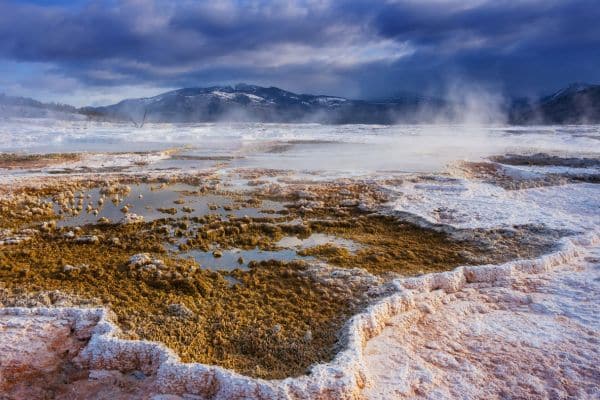
Outdoor enthusiasts can also embark on thrilling hikes to witness the astonishing power of the park’s geysers, hot springs, and mud pots.
Best Hikes in Yellowstone
Yellowstone National Park, renowned for its geothermal marvels, rich landscapes, and diverse fauna, presents a host of hiking adventures.
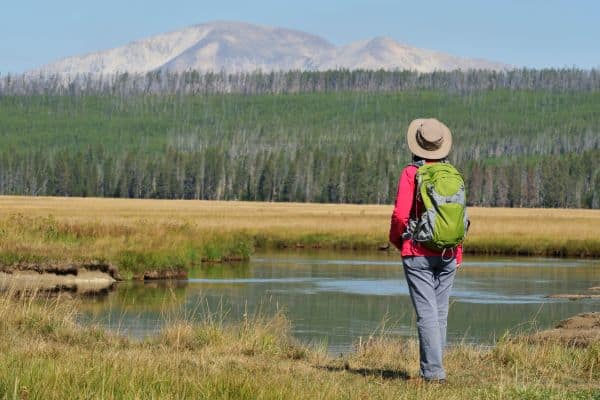
Here’s a curated list of some of the top hikes, complete with trail lengths:
- Uncle Tom’s Trail (1 mile round trip): This steep descent via a series of staircases offers stunning views of the Lower Falls and the Grand Canyon of the Yellowstone. It’s challenging, but the vistas make every step worthwhile.
- Mount Washburn (6.4 miles round trip): Often regarded as the crown jewel of Yellowstone hikes, this trail offers 360-degree panoramic views. Keep an eye out for bighorn sheep and occasional grizzly sightings.
- Lone Star Geyser Trail (4.8 miles round trip): A relatively easy and flat hike, leading to the Lone Star Geyser. A great choice for those wanting to escape the crowds of the more popular geysers.
- Mystic Falls (2.4 miles round trip): Embarking from Biscuit Basin, this moderate trail takes you past thermal wonders to a charming waterfall. For extended views, loop onto the Fairy Creek Trail.
- Ribbon Lake Trail (6.7 miles loop): A gentle circuit leading to the clear Ribbon Lake, with a stunning viewpoint of the Grand Canyon of the Yellowstone from Clear Lake.
- Trout Lake Trail (1.2 miles round trip): A brief yet scenic hike near the Northeast Entrance. The serene Trout Lake becomes a hotspot for watching cutthroat trout during their June spawning.
- Specimen Ridge (3 to 15 miles, depending on the route): A challenging trail revealing petrified forests and panoramic views of the Yellowstone River and its valleys.
- Avalanche Peak (4 miles round trip): For those seeking an adrenaline rush, this steep ascent promises mesmerizing views of the Absaroka Mountains and Yellowstone Lake.
- Fairy Falls (5 to 7 miles round trip, depending on the extension): An accessible trail that leads to one of Yellowstone’s tallest cascades. Extend the journey by trekking to the Imperial Geyser.
- Lamar River Trail (5 miles round trip to the cache, but can be extended deeper into the backcountry): Perfect for intrepid hikers aiming to experience Yellowstone’s wild side. The Lamar Valley, often dubbed the “Serengeti of North America,” is teeming with wildlife.
While Yellowstone is a realm of unparalleled beauty, always remember it remains a wild, unpredictable ecosystem. Safety precautions and adequate preparations are crucial.
Best Hikes in Grand Teton National Park:
Grand Teton National Park, with its iconic jagged peaks, alpine lakes, and pristine wilderness, offers an array of unforgettable hiking experiences.
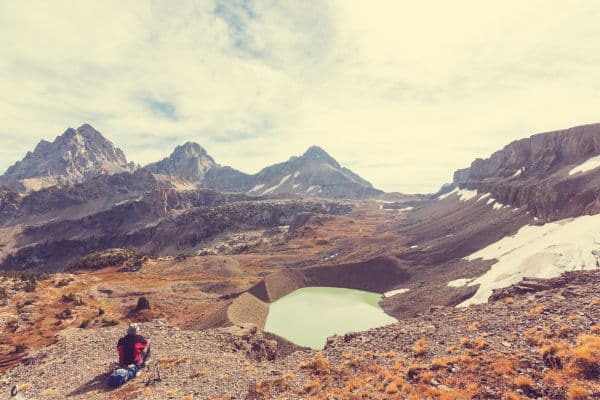
Below are some of the top hikes, complete with their respective lengths:
- Taggart Lake Trail (3.2 miles round trip): This relatively easy trail offers magnificent views of the Tetons and leads to the serene Taggart Lake. It’s especially scenic during the fall.
- Jenny Lake Loop (7.6 miles round trip): Skirting the shores of the famous Jenny Lake, this trail offers stunning lake vistas set against the backdrop of the Tetons.
- Cascade Canyon Trail (8 to 14 miles round trip, depending on depth into the canyon): Begin with a boat ride across Jenny Lake, then hike into a glacially-carved canyon with impressive views of the Grand Teton and other peaks.
- Paintbrush Canyon to Cascade Canyon Loop (19.7 miles loop): A challenging but immensely rewarding loop, showcasing some of the best panoramic views of the park and a diversity of terrains.
- Phelps Lake Loop (7 miles round trip): This trail takes you around the picturesque Phelps Lake with multiple viewpoints showcasing the beauty of the Tetons.
- Death Canyon Trail (7.5 miles round trip to Static Peak Divide): A moderate-to-strenuous hike offering spectacular views of Phelps Lake, alpine meadows, and the towering walls of Death Canyon.
- Surprise and Amphitheater Lakes (10 miles round trip): A steeper trail leading to two beautiful glacial lakes, offering close-up views of the Grand Teton.
- Lakeshore Trail (2.5 miles round trip): A family-friendly, flat loop around Colter Bay on Jackson Lake, providing beautiful views of the Tetons reflecting in the water.
- Garnet Canyon Trail (8.4 miles round trip): This trail, which ventures into the base of the Tetons, offers hikers a chance to experience the alpine environment of Grand Teton National Park.
- Signal Mountain Summit (6.8 miles round trip): A moderate hike leading to the summit of Signal Mountain. From the top, one can enjoy panoramic views of the Jackson Hole valley and the Teton Range.
Grand Teton National Park is not just a visual treat but also a place of rugged wilderness. It’s essential to be prepared, respect wildlife from a distance, and take safety precautions while hiking in this breathtaking landscape.
Scenic drives are another fantastic way to soak in the beauty of both parks. In Grand Teton, the Teton Park Road offers breathtaking views of the mountain range, and the Signal Mountain Summit Road rewards drivers with panoramic vistas.
In Yellowstone, the Grand Loop Road takes you through the park’s diverse landscapes, offering glimpses of wildlife and iconic landmarks along the way.
Wildlife Sightings in Yellowstone and Grand Teton National Parks
Yellowstone and Grand Teton National Parks are both jewels of the American West, renowned not only for their dramatic landscapes but also for their diverse wildlife. However, each park offers distinct wildlife encounters based on its unique ecosystems.
In Yellowstone, the vast expanses often earn it the title of the “American Serengeti.” The Lamar and Hayden Valleys resonate with the thundering presence of large bison herds.
In stark contrast to many places in the world, Yellowstone offers one of the most accessible and reliable opportunities to observe wolves in the wild.
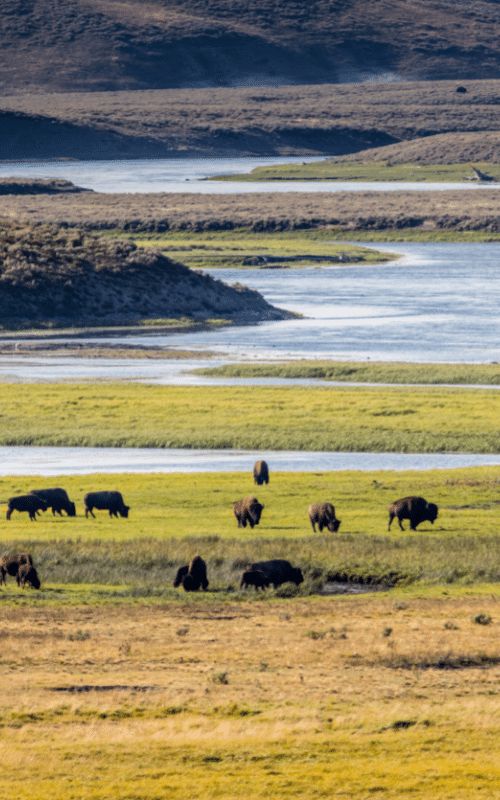
Elk are a frequent sight, particularly in areas like the Mammoth Hot Springs. But the king of the wilderness here is undoubtedly the bear, with both grizzly and black bears calling the park home.
Beyond these larger mammals, Yellowstone is a haven for smaller creatures like the badger, pika, and the distinct Yellowstone red fox.
The skies are not to be left out, with the park being a sanctuary for over 300 bird species, including the majestic bald eagle, ospreys, and the rare trumpeter swan.
On the other hand, Grand Teton National Park offers a more intimate wildlife experience. While the park has bison, the herds are typically not as expansive as those in Yellowstone.
Grand Teton is particularly renowned for its moose, often spotted wading in the park’s streams or meandering through its forests. Both grizzly and black bears exist in Grand Teton, though they are generally more elusive than their Yellowstone counterparts.
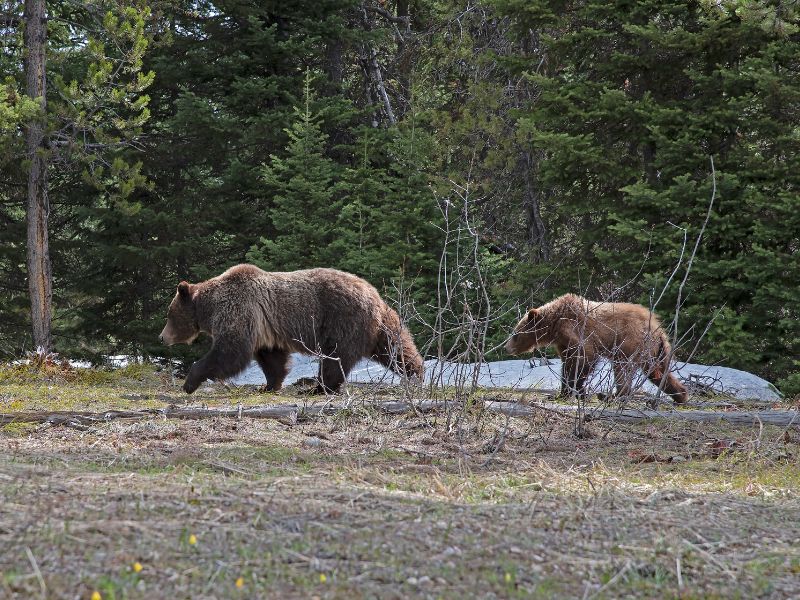
As you scale the park’s heights or explore its nooks, you might catch a glimpse of marmots, pika, or even the elusive wolverine.
The birding experience in Grand Teton is equally enriching, with the skies frequented by bald and golden eagles, ospreys, and a myriad of hawk species.
Camping in Yellowstone and Grand Teton National Parks
Yellowstone and Grand Teton National Parks, both nestled in the heart of the American Rockies, are sought-after destinations for campers and outdoor enthusiasts.
However, each park offers its own unique camping experience, catering to different preferences and expectations.
Yellowstone National Park boasts the larger expanse, and with that comes a wider variety of camping options. The park has 12 campgrounds with over 2,000 sites.
These range from the more developed campgrounds like Mammoth, Grant Village, and Canyon, which offer amenities such as RV hookups, dump stations, and laundry facilities to the more primitive campgrounds like Slough Creek and Pebble Creek, which provide a more rustic and back-to-nature experience.
Given Yellowstone’s vastness, choosing a campground can also mean choosing the kind of terrain and environment you want to be surrounded by, be it geothermal features, expansive valleys, or dense forests.
Additionally, Yellowstone’s backcountry is a maze of trails and wilderness, offering over 300 backcountry campsites for the adventurous.
Grand Teton National Park, while smaller in comparison, offers an unparalleled alpine ambiance for campers. The park has six campgrounds with approximately 1,000 sites.
The views from these campgrounds are often stark and dramatic, with the jagged Teton Range serving as a constant backdrop. Campgrounds like Jenny Lake are popular for their proximity to the lake and the mountains, providing quick access to hiking and boating.
Colter Bay, on the other hand, offers more amenities, including RV sites, showers, and a nearby village with stores and restaurants.
For those seeking solitude, Grand Teton offers several primitive campgrounds like Gros Ventre and Lizard Creek.
The park’s backcountry is less expansive than Yellowstone’s but offers a rugged high-mountain experience, with pristine lakes and towering peaks for those willing to venture off the beaten path.
Accessibility and Amenities in Yellowstone and Grand Teton National Parks
Yellowstone and Grand Teton National Parks, while geographically close, offer different experiences in terms of accessibility and amenities. Each park has tailored its facilities to accommodate a broad range of visitors, ensuring that their natural wonders can be enjoyed by many.
Accessibility in Yellowstone: Yellowstone is vast, covering over 2.2 million acres. It has five entrances: North, Northeast, East, South, and West, making it accessible from multiple directions.
The park has a well-maintained road system that reaches most of its primary attractions, including Old Faithful, the Grand Canyon of the Yellowstone, and Mammoth Hot Springs. However, due to its size, traveling between sites can take time.
Some areas of the park, especially the interior, can only be accessed by multi-day hikes or horseback, making them less accessible to the general visitor.
During winter, most roads are closed to regular vehicles but can be traversed using guided snowmobile or snowcoach tours.
Amenities in Yellowstone: The park offers a wide range of services, including lodges, restaurants, general stores, and gas stations. Campgrounds vary from developed sites with RV facilities to primitive backcountry spots.
Educational centers, like the Canyon Visitor Education Center, offer interactive exhibits and ranger-led programs.
There are also numerous picnic areas, restrooms, and even some locations with Wi-Fi.
Accessibility in Grand Teton: Grand Teton is more compact, covering around 310,000 acres. It has a primary entrance to the south, connecting directly with Yellowstone, and other access points along its eastern boundary.
The Teton Park Road and Jenny Lake Scenic Drive offer impressive views and easy access to key landmarks.
The park’s smaller size makes it somewhat easier to navigate and explore multiple sites in a shorter time. Like Yellowstone, winter brings road closures, but parts of the park remain accessible for winter sports and activities.
Amenities in Grand Teton: Grand Teton might be smaller, but it doesn’t skimp on amenities. There are multiple campgrounds, some with full RV facilities.
The park boasts lodges, such as the Jackson Lake Lodge, which offer upscale dining and accommodation options. There are also simpler provisions like picnic areas, general stores, and marinas for boat rentals on the lakes.
While visitor centers are fewer than in Yellowstone, they are comprehensive, with the Craig Thomas Discovery and Visitor Center being a highlight, providing immersive educational experiences.
In Summary: While both parks are designed to be welcoming and accessible to visitors, Yellowstone offers a more expansive, diverse experience with a broader range of amenities spread out across its vast landscape.
In contrast, Grand Teton provides a more compact, focused experience with easy access to its primary attractions and a concentration of amenities that cater to both casual visitors and outdoor enthusiasts.
Conclusion
In the grand debate between Grand Teton National Park and Yellowstone National Park, it’s important to remember that both parks have their own allure and can provide unforgettable outdoor experiences.
Yellowstone, as the older and larger park, offers a vast expanse of natural wonders, covering around 3,500 square miles. Its geothermal features, such as the legendary Old Faithful geyser and its own Grand Canyon, are sure to leave visitors in awe. With its more extensive network of paved roads, Yellowstone provides easy access to its diverse landscapes.
Meanwhile, Grand Teton boasts breathtaking mountain scenery, crystal-clear glacial lakes, and an extensive trail system for hikers to explore. The park’s majestic peaks, including the iconic Grand Teton itself, create a dramatic backdrop that nature enthusiasts won’t want to miss.
Both parks are home to an abundance of wildlife, with opportunities to spot the “big five” animals, including the largest bison herd in the US found in Yellowstone. Whether it’s watching a grizzly bear roam through the wilderness or observing a bald eagle soaring above, encountering these creatures in their natural habitat is a remarkable experience.
When considering accessibility, Grand Teton is situated closer to the town of Jackson, allowing for easier exploration in a shorter amount of time. On the other hand, fully experiencing Yellowstone may require more driving and time, but the journey is undoubtedly worth it to witness its unparalleled natural wonders.
Entrance fees, dining options, and accommodations are available in both parks. However, Yellowstone offers a wider range of choices in these categories due to its larger size and popularity.
In the end, the choice between Grand Teton National Park and Yellowstone National Park comes down to personal preferences and priorities. Both parks offer unique natural beauty and opportunities for outdoor adventures that will leave visitors with incredible memories. So, whether you decide to explore the rugged mountains of Grand Teton or marvel at the geothermal wonders of Yellowstone, you can’t go wrong with either choice.
FAQ
Q: Should I visit Grand Teton National Park or Yellowstone National Park?
A: While it is recommended to visit both parks if possible, if you have to choose, it depends on your preferences. Let’s explore the differences!
Q: What is the size of Grand Teton National Park compared to Yellowstone National Park?
A: Grand Teton National Park covers around 484 square miles, while Yellowstone National Park is much larger, spanning around 3,500 square miles.
Q: What are the notable geothermal features in Yellowstone?
A: Yellowstone National Park is famous for its diverse range of geothermal features, including the iconic Old Faithful geyser and its own Grand Canyon.
Q: What kind of scenery can I expect in Grand Teton National Park?
A: Grand Teton National Park is known for its stunning mountain scenery, crystal-clear glacial lakes, and an extensive network of hiking trails.
Q: Which animals can I expect to see in both parks?
A: Both Grand Teton and Yellowstone offer excellent opportunities for wildlife viewing, with sightings of the “big five” animals being common. Yellowstone is home to the largest bison herd in the US.
Q: How accessible are the parks and what amenities do they offer?
A: Grand Teton National Park is closer to the town of Jackson and can be explored in a shorter amount of time. Yellowstone requires more driving and time to fully experience. Both parks offer camping options, dining, and accommodations, with Yellowstone having a greater variety.

